This brief and relatively unimportant campaign is however of great import and interest to the military vexillologist, for the surrender of the garrisons of Bastia on 15th May 1794 and of Calvi on 12th July of the same year gave to the British Army five almost unique trophies - two 1791 pattern colours of the regular army [1] and three colours from volunteer battalions. These five trophies form the basis for this article.
Campaign
The campaign itself resulted as a side show after the repulse of the British and Allied efforts at Toulon. Hood's fleet; left France at the beginning of 1794 intending to aid the Corsican rebel and patriot Paoli to free his island from French control. On 18th February the fleet and army forced the French out of their initial defence position at San Fiorenzo, and on the 27th of the same month they invested the first of the two main French positions on Corsica - Bastia. Mainly because of the participation of the future Admiral Nelson the navy is often credited with the lion's share of the credit for the siege of Bastia (and of Calvi for that matter) but in truth it was quite a close co-operative effort between the two arms and with a strong British fleet off shore there was little hope for the French defenders.
The garrison of Bastia surrendered on 15th May. The conquest of Corsica was completed when Calvi surrendered on 10th August, it had been under siege since 19th May, and in the meantime, from June 21st, George III had become King of Corsica. The occupation didn't last; long and by the middle of 1795 Paoli was in revolt against the new Government - in September 1796 the British evacuated Corsica and abandoned it back to the Corsican rebels and, ultimately, re-occupation by the French Army.
The surrender of the two French garrisons included the surrender of their colours, [2] two which were returned to England but, for some reason, did NOT end up in the semi-official trophy collection at the Royal Hospital at Chelsea. [3]
Instead the five colours appear to have been retained by one of the General Officers present with the Army for, in the early part of the present century, they were presented to the now disbanded Museum of the Royal United Services Institute, in Whitehall. When this collection was broken up they ought to have been transferred to the National Army Museum in Chelsea - finally arriving at their destination after 150 years. [4]
Unfortunately for vexillologists the colours in question were not amongst those passed to the N.A.M. and once again they seem to have disappeared. Correspondence with the N.A.M. in Chelsea and with the curators of the reserve collection at Sandhurst have failed to find any clue to their current whereabouts. Although the now-retired Director of the National Army Museum, William Carman, believes that they were at one time at Chelsea they do not appear in any catalogues. The search continues...
Illustration I : 26e Regiment d'Infanterie, 2e Bataillon
The colour of the first battalion of each regiment [5] was to be identical throughout the Army (as, essentially, was the White "Colonel's Colour" which it replaced) except for the appropriate numeral in the centre of the white cross - cf. illustration II below.
The colour of the second battalion bore the same cross and motto as the first battalion but omitted the tricolour border and tricolour in the first canton. In the latter's place each canton was to have a coloured geometric device. The regiments were divided into groups of twelve, each group having a distinctive hue, which was also the hue of their regimental facings. Each group of twelve regiments repeated the same sequence of geometric devices in the canton. Thus the second battalion of the 26e (see illustration I below) was of the second regiment in the second group and had a lozenge in each canton in the group facing colour of "rose". The actual pattern accepted by the Assembly in August showed that the canton should have been of the facing colour with a white lozenge rather than the reverse as actually constructed here, i.e. a white canton with a facing colour lozenge.
Unfortunately too few examples of the 1791 pattern colours still survive for us to make any inference as to whether this reversal of hues was a one-off mistake or whether it was repeated in the other groups or on other designs within the groups. Only eight colours survive of the 1791 pattern and five of these are little more than the central numeral and wreath with a few surrounding fragments - far too small a sample to realistically draw any conclusions.
Illustration I : Colour of the 2e Batallion of the 26e Regiment d'Infanterie (colours were issued one per battalion). White cross on a white field; rose-pink lozenge in the centre of each canton; green wreath at the centre of the cross; numeral and mottoes in golden yellow; tricolour lozenges (red/white/blue) at the end of each arm of the white cross. [6]
The colour is of the official 'horizontal tricolour' pattern of blue over white over red (as in the first canton of the colour of the first battalion of the line regiments) but in place of the official 'LA PEUPLE FRANCAIS, LA LIBERTE' it bears, in gold letters, the motto 'VIVER LIBER IO MORI' within a green wreath. This motto is, according to Major R. Holden, Corsican patois for the French phrase 'Je meurs pour vivre libre'. The reverse is identical except that the wreath encloses the motto 'REPUBLICA FRANCESA' also in gold.
If this colour is of the 1791 Decree, as it seems to be, it is the only surviving example. However it is not impossible that this colour is of the later 1791/early 1792 era like Illustration IV below. During this period there were a great number of variations of design of colour, almost at the whim of the Departments. [8]
[1] "Regular army" refers to the regiments which existed as a part of the military establishment before the raising of the vast number of "volunteer" battalions in the period 1791-1792.
Sadly it has not proved possible to examine the original extant colours taken at Bastia & Calvi (see text) and therefore the illustrations which accompany this essay are based on sources which whilst reliable are nonetheless secondary. There have been a number of illustrations published of one or more of these colours, the latest being in Pierre Charrie's seminal work, but as far as I can tell the only illustrations drawn from sight of the original items are those which accompanied Major Holden's article in The Journal of the Royal United Services Institute and even this did not include the colours of the ler battalion of the 52e infanterie.
For the above reason I have followed Major Holden's drawings for the illustrations here almost slavishly, although supported by and compared with other illustrations of both these and other similar colours. Should the actual colours come to light once more, however, then I will, of course provide comparative illustrations to this journal.
This article appears in MagWeb (Magazine Web) on the Internet World Wide Web. If the 1794 campaign on Corsica is remembered today by anyone beyond the most dedicated devotee of the Revolutionary and Napoleonic era, it is probably because during the course of the second of the two sieges, which constituted its main military element, the then Captain of His Majesty's Ship Agamemnon, one Horatio Nelson, lost the sight of his right eye to a blast of sand ricocheted by a cannon-ball which had passed over his head.
If the 1794 campaign on Corsica is remembered today by anyone beyond the most dedicated devotee of the Revolutionary and Napoleonic era, it is probably because during the course of the second of the two sieges, which constituted its main military element, the then Captain of His Majesty's Ship Agamemnon, one Horatio Nelson, lost the sight of his right eye to a blast of sand ricocheted by a cannon-ball which had passed over his head.
Illustration II : 52e Regiment d'Infanterie, ler Bataillon
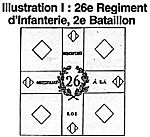 Both of these colours are of the 1791 'regular army' pattern. The 1791 pattern infantry colour was introduced by a decree of the National Assembly of 30th June 1791, although the final designs were not approved until 19th August of the same year. The whole scheme was the work of Challiot de Prusse who was responsible for the design of the French military's flags until the end of the Empire.
Both of these colours are of the 1791 'regular army' pattern. The 1791 pattern infantry colour was introduced by a decree of the National Assembly of 30th June 1791, although the final designs were not approved until 19th August of the same year. The whole scheme was the work of Challiot de Prusse who was responsible for the design of the French military's flags until the end of the Empire.
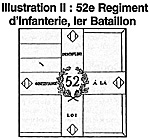 Illustration II : Colour of the 1er Batallion of the 52e Regiment d'Infanterie. Details and colouring of cross as for illustration I above. A horizontal tricolour of blue over white over red filling the whole of the first canton; other canton plain white but edged, clockwise, alternately red/blue/red/blue/red (see illustration) [7]
The 1791 pattern colours were 154cm on the pole by 162cm flying.
Illustration II : Colour of the 1er Batallion of the 52e Regiment d'Infanterie. Details and colouring of cross as for illustration I above. A horizontal tricolour of blue over white over red filling the whole of the first canton; other canton plain white but edged, clockwise, alternately red/blue/red/blue/red (see illustration) [7]
The 1791 pattern colours were 154cm on the pole by 162cm flying.
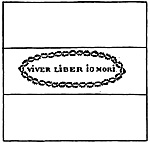 Illustration III : Colour of the 'Volontaires du Departement de la Corse' This colour is evidently a variant of the first pattern of colour authorised by the National Assembly on 4th August 1791 - although it differs from the decreed design in its unusual mottoes.
Illustration III : Colour of the 'Volontaires du Departement de la Corse' This colour is evidently a variant of the first pattern of colour authorised by the National Assembly on 4th August 1791 - although it differs from the decreed design in its unusual mottoes.
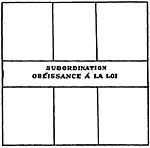 Illustration IV: 1er Batallion of the 'volontaires de 1'Abeyon'. This colour does date from the least regulated era of volunteers colours referred to for illustration III above. The form of the central white horizontal panel gives the general impression of the traditional French "white cross of St Denis" as used on the colours of the Line army and a number of the surviving volunteer colours from this period. The colour is a tricolour of, from the pole, blue / white / red with a central overall white stripe bearing the motto 'SUBORDINATION, OBEISSANCE A LA LOI' (again a similarity to the Line army) in gold. The obverse has the dedication '1er BATAILLON DAVERON REPUBLIQUE FRANCAISE' also in gold. This colour is 175cm square.
Illustration IV: 1er Batallion of the 'volontaires de 1'Abeyon'. This colour does date from the least regulated era of volunteers colours referred to for illustration III above. The form of the central white horizontal panel gives the general impression of the traditional French "white cross of St Denis" as used on the colours of the Line army and a number of the surviving volunteer colours from this period. The colour is a tricolour of, from the pole, blue / white / red with a central overall white stripe bearing the motto 'SUBORDINATION, OBEISSANCE A LA LOI' (again a similarity to the Line army) in gold. The obverse has the dedication '1er BATAILLON DAVERON REPUBLIQUE FRANCAISE' also in gold. This colour is 175cm square.
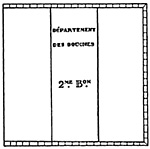 Illustration V : 2e Bataillon du Department des Bouches du Rhone. The pattern is that which Pierre Charrie (see sources) identifies as "Volunteer Tricolour Pattern, type 1", and is one of only five surviving examples of this pattern. It is a simple tricolour of blue / white / red with a narrow border along the three outer edges of alternate blue, red, white. On the obverse central white panel is the inscription 'DEPARTMENT DES BOUCHES' '2me Bon' in gold, note that the inscription does not overlap onto the other stripes. The reverse bears the inscription 'EGALITE' 'LIBERTE' '2me Bon' also in gold and on the white panel only.
The colour is 210cm square.
Illustration V : 2e Bataillon du Department des Bouches du Rhone. The pattern is that which Pierre Charrie (see sources) identifies as "Volunteer Tricolour Pattern, type 1", and is one of only five surviving examples of this pattern. It is a simple tricolour of blue / white / red with a narrow border along the three outer edges of alternate blue, red, white. On the obverse central white panel is the inscription 'DEPARTMENT DES BOUCHES' '2me Bon' in gold, note that the inscription does not overlap onto the other stripes. The reverse bears the inscription 'EGALITE' 'LIBERTE' '2me Bon' also in gold and on the white panel only.
The colour is 210cm square.
Notes
[2] Only five colours were surrendered upon the two occasions which suggests, given the size of the garrisons, that a number of other were hidden or destroyed before the actual capitulations.
[3] Colours started to be laid up at Chelsea at around this time, although a number would continue to be kept by George III and the Prince Regent at Windsor. The fact that these colours didn't go to Chelsea may, in fact, have turned out for the best since they are in a far better state of preservation than the ones that did. These latter have, to all intents and purposes, totally decayed.
[4] Or close to anyway since the National Army Museum is next door to the Royal Hospital.
[5] Infantry regiments at this were uniformly of two battalions, only later were regiments expanded to three, four, five or more battalions.
[6] The original 1791 pattern had a golden-yellow fleur-de-lis at the end of each arm of the white cross but with the abolition of the monarchy a Decree of 28th November 1792 ordered that these should be covered by tricolour patches - in fact they were often simply covered with a white patch or even merely cut off.
[7] The surviving colours, contemporary illustrations, and the 'pattern' approved by the Assembly all show a number of minor variations in this tricolour edging.
[8] Pierre Charrie (see Bibliography) gives this colour as being of the same pattern as illustration IV, BUT he erroneously states that the tricolour is vertical and not horizontal which may have affected his identification.
Bibliography
CHARRIE, Pierre Drapeaux et Etendards de la Revolution et De L'Empire; Paris 1982.
HOLDEN, Major R Regimental Colours in the Museum of the RUSI, in the Journal of the Royal United Services Institute for 1922(?).
HOLLANDER, O. Les Drapeaux des Demi-Brigades D'Infanterie de 1794 a 1804; Paris 1913.
FITCHETT, W.H. How England Saved Europe; London 1909.
RICO (Rigondaud, Albert) Le Plumet plates 222 & 224; Paris 1992.
Notes on Illustrations
Back to Table of Contents -- First Empire #34
© Copyright 1997 by First Empire.
Other military history articles and gaming articles are available at http://www.magweb.com